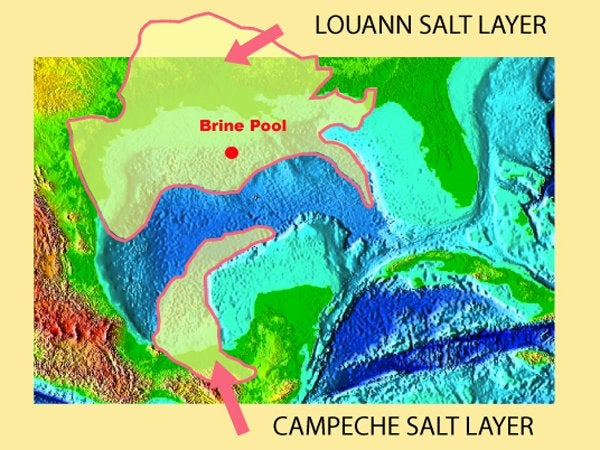This article was published in Scientific American’s former blog network and reflects the views of the author, not necessarily those of Scientific American
The Gulf of Mexico is known for many things, and sad to say, most are bad: hurricanes, oil spills ... the infamous Dead Zone. But there is a Wonder of Nature that the gulf should be known for but isn't. That would be the Brine Lakes of the Gulf of Mexico, amazingly located inside the gulf.
The video below was captured by the ROV Hercules of Nautilus Live, Bob Ballard's ocean exploration program that streams its adventures live on the web so anyone can watch. Though the lakes they probed were smallish, some found in the gulf are over 12 miles long. What exactly are they, and where did they come from?
On supporting science journalism
If you're enjoying this article, consider supporting our award-winning journalism by subscribing. By purchasing a subscription you are helping to ensure the future of impactful stories about the discoveries and ideas shaping our world today.
During the Jurassic, a shallow sea lay on the site of the current Gulf of Mexico,according to Bob Carney of Louisiana State University. This sea was severed from the rest of the ocean. As a result, it grew increasingly salty and finally evaporated. The amount of salt created when a Gulf-of-Mexico-sized sea evaporates – even a shallow one -- is mind boggling. We know that because those salt deposits thus created still exist under the Gulf and the southern United States as far north as Arkansas. At their thickest, they measure 5 miles deep. That is a lot of margaritas.
The salt deposits form two chunks – the Louann Salt layer, which stretches from Arkansas to the northern Gulf of Mexico, and the Campeche layer, which starts at the base of the Yucatan peninsula and runs up the middle of the Gulf.

Eventually, the dried-up sea was re-connected to the world's oceans. But by the time this happened, sediment had already accumulated on top of it, preventing it from redissolving. By this time, the Rocky Mountains had begun to rise. As they eroded, the sediment thus created further piled up on the salt in the Gulf. As the weight of this sediment grew, it squeezed the salt below. Because salt is less dense than the sediment above it, in certain places it rose through the overlying layers and extruded itself on the seafloor through a process called salt tectonics.
As the salt neared the seabed, sea water infiltrated it and at last dissolved the salt into a brine about four times saltier than seawater. The brine oozed out of the sediment, but was so dense it could not mix easily with seawater. Instead, it puddled on the seafloor. At the interface between the seawater and the brine pools, we see a “halocline”, or visible boundary between density layers. This is not unlike the effect you can see when you observe the boundary between a layer of oil and water in a measuring cup – or the halocline present between freshwater and encroaching seawater in the flooded caves of Mexico:
The result is the appearance of a lake within an ocean. Disturbing the lakes produces exactly the same effect we see at the interface of water and air, except that it's all water down there. This explains the waves you saw when the ROV broke the surface or disturbed it with backwash from its thrusters. These waves can wash up on the shore of the pool just like waves at a beach, as you also saw. The brine is so dense that submarines and ROVs can “land” on the lakes and float on the surface. They must use their thrusters to submerge themselves in the pool, as their ballast is calculated to provide neutral buoyancy in ordinary seawater.
Of course, there is one more notable aspect to these lakes: in addition to being ultradense, they are also ultralethal. Although bacteria and archaea that can breathe methane – often present in abundance in brine -- can live in it, large animals cannot survive. They will become fish pickles if they somehow “fall” in. Still, daredevil mussels that symbiotically partner with the methane-breathing bacteria (which shack up in their gills) often crowd the shore.
Brine pools are not unique to the Gulf of Mexico. They also occur in the Red Sea and near Antarctica. No doubt if humans could breathe water and withstand abyssal pressures, these areas would be protected reserves and the Gulf of Mexico would be known for something like Brine Lakes National Monument instead of death zones, flaming derricks, and oil slicks. But we cannot, and instead they lie in obscurity, accessible only to those with big bucks, fancy toys, and, fortunately for us plebes, YouTube channels.
________________________________________
p.s. Nautilus Live recently also produced this jaw-dropping footage of Hercules's submarine encounter with a sperm whale 1,962 feet (598 m) below the surface a few months ago. It was widely covered by the mainstream media, so I chose not to post about it here. But IN CASE you somehow didn't see it, you should have a look: